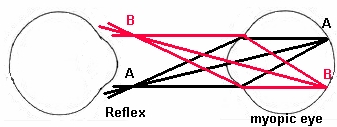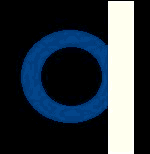| 1. Retinoscopy is an instrument for determining
__1__ the refractive state of the eye.
2. There are two types of retinoscope: __1__
and __2__ retinoscope. The __3__
retinoscope projects an oblong streaks into
the patient's eye and is therefore easier than
the __4__ retinoscope
in determining an astigmatic error.
3. A light is directed into the eye and the movement of the reflex
is observed.
If the reflex moves in the same direction as the
retinoscope, this is called with movement
and we add __1__lenses
and the eye is __2__ at this working distance.
If the reflex moves in the opposite direction to
the retinoscope, this called against
movement and we add __3__
lenses and the eye is __4__ at this
working distance.
4. A retinoscope is made up of a light source, a condensing lens
and a mirror. Although the
image on the patient's retina moves in the same
direction as the retinoscope light is moved
on the patient's eye. This image ie reflex will
appear to the observer to move in either the
same direction ie. with or in the opposite direction
ie. against.
Two factors affect the movement of the reflex and
there are:
1 ________________
2 ________________

Figure 1
5. When refracting a myopic eye, as the image A moves
to B we see the reflex focusing at the
far point of the patient's eye and moving in a direction
__1__ both the image on the retina
and the direction of the retinoscope's light on
the outside of the patient's eye.
If our eye is within the patient's far point you
will see __2___ motion; if we are outside
the far point you will see __3__
motion because the light rays have crossed at the far point.

Figure 2
6. When refracting a hypermetropic eye, the observer again sees
the reflex at the far point of the
patient's eye (which is now behind the eye),
so the reflex will now move in the __1__ direction
as the image on the retina and the retinoscope's
light on the outside of the patient's eye.
7. In retinoscopy at the end point (also called neutrality), the
pupil of the patient is suddenly filled
with light and __1__
motion is observed.
Neutrality of the reflex occurs when the far point
of the patient's eye coincides with the cornea
of the examiner's eye.
8. An examiner working at 67cm ( 2/3 m ) will observe an against motion
when refracting a
-2.00D myopic patient (without any lenses being
placed in front of the patient). When
refracting the same eye at a working distance of
50cm he observes neutrality. When the
examiner moves to 40 cm he will observe __1__
of the eye.
9. So far the movement of the reflex applied to divergent light
from the retinoscope. If the light is
convergent when it strikes the eye, all relative
movements are reversed. Therefore, with
convergent light from the retinoscope, a with movement
indicates that the eye is __1__ at the
working distance and an against movement indicates
that the eye is __2__ at the working
distance.
10. The vergence of the light can be changed in streak retinoscope.
In the UK, the light
emergences from the retinoscope with
the handle down is __1__ and is __2__
with the
handle up.
11. The examiner can select any distance at which to work, but in
general 67 cm or 50 cm is used
depending on the length of the examiner's
arm.
If using 67cm, neutrality without lenses
means that the eye is 1.50 D __1__ and an
emmetropic eye requires __2__
lens for neutrality. Therefore the total power must be adjusted
by __3__
if using 67cm.
If the working distance is 50 cm, the
total power found at neutrality must be adjusted by
substracting __4__.
12. Using the streak retinoscope with the handle down, the following motion
is observed without
lenses at the working distance of 67cm.
There are three possibilities:
1. myopia of less than ____
2. ____
3. ____
13. The following motion is observed with a streak retinoscope (handle
down) at a distance
of 67cm.
The patient is __1__
and he requires a lens greater than __2__.
14. As neutrality is approached, the reflex becomes __1__,
__2__ and __3__.
When the
refractive error is neutralized, the
pupil is suddenly filled with light.
15. One can verify the neutral point by moving forward a few cm and then
backward a few cm.
As he moves forward (with the handle
down), there would be __1__ motion and as
he moves
backward, there would be __2__
motion.
16. The final refractive power is adjusted for the working distance.
If the working distance
is 67cm, the net retinoscopy will
_1__ D less hypermetropic or more myopic
than that obtained
from the retinoscopy.
17. When the retinoscopy reveals +2.00-1.75 X 180 at working distance of
67cm, the final
refraction will be __1__..
This cylinder portion of the correction is __2__.
If the retinoscopy reveals neutralization
at +0.50 -1.00 X 90 at 50cm, the final refraction will
be __3__.
18. During retinoscopy, you may neutralize one meridian with sphere and
the other with the
cylinder; or alternatively you can use
spheres to neutralize the two meridians.
Example 1.
If you are working at a distance of 67cm, and you find that
with the streak at 90 degrees +2.00 D sphere neutralized
the reflex; with the streak at 180 degrees (with the sphere in place)
a -2.00D cylinder neutralizes the reflex. The patient's final refraction
is __1__
Example 2
Your working distance is 50cm, and you find that that with
the streak at 45 degrees, -1.00D sphere neutralized the reflex, with the
streak at 135 degrees (with the streak in place a -1.50 D cylinder neutralizes
the reflex. The patient's final refraction is
__1__
19. You may use sphere to neutralize both axis.
Example 1:
With the streak at axis 45 degrees a -3.00D lens neutralizes the reflex
With the streak at axis 135 degrees, a +2.00 lens neutralizes the reflex.
The result of the retinoscopy is __1__
-5.00 X 45
If the working distance is 67cm, the final refraction is __2__
Example 2:
With the streak at axis 90 degrees, a +3.00D lens neutralizes the reflex
With the streak at axis 180 degrees, a +6.00D lens neutralize the reflex
The result of the retinoscopy is +6.00 __1__X
90
If the working distance is 67 cm, the final refraction is __2__
Example 3
With the streak at axis 45 degrees, a -1.00 D lens neutralizes the
reflex.
With the streak at axis 135 degrees, a -2.00D lens neutralizes the
reflex.
The result of the retinoscopy is -1.00D -1.00 X __1__
If the working distance is 67 cm, the final refraction is __2__.
20. In patients with dilated pupil, the reflex in the periphery of the
pupil may be opposite in
motion to that in the central area of
the pupil. This results from the difference in ____1____
of the lens periphery. To gain an accurate
result, only the ____ 2 ____ should be regarded.
|




